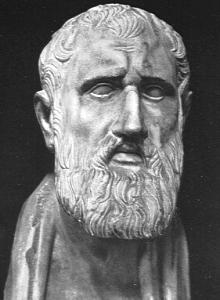Difference between revisions of "Zeno of Citium" - New World Encyclopedia
Keisuke Noda (talk | contribs) m |
Keisuke Noda (talk | contribs) m |
||
| Line 37: | Line 37: | ||
[[Category:Cypriot people]] | [[Category:Cypriot people]] | ||
[[Category:Ancient Greeks]] | [[Category:Ancient Greeks]] | ||
| − | [[Category: | + | [[Category:Philosophy and religion]] |
{{Credit|46811360}} | {{Credit|46811360}} | ||
Revision as of 09:32, 11 May 2006
- Note: Zeno of Citium should not be confused with Zeno of Elea.
Zeno of Citium (The Stoic) (sometime called Zeno Apathea) (333 B.C.E.-264 B.C.E.) was a Hellenistic philosopher from Citium, Cyprus. He was the son of a merchant and a student of Crates of Thebes, the most famous Cynic living at that time in Greece. Zeno was, himself, a merchant until the age of 42, when he started the Stoic school of philosophy. Named for his teaching platform, the stoa ("stoa" is Greek for "porch"), his teachings were the beginning of Stoicism. None of Zeno's works have survived, but his teachings have passed on, including his main concept that tranquility can best be reached through indifference to pleasure and pain.
He was described as haggard, tanned person living a spare, ascetic life. This coincides with the influences of cynic teaching, and is, at least in parts, continued in his stoic philosophy. Having been companionable, the king, Antigonos of Macedonia, often abided by him.
Zeno is also the first utopian anarchist in the west and thus an important precursor of the anarchism we know today. In The Crooked Timber of Humanity, Isaiah Berlin describes Zeno's beliefs as follows
- Men are rational, they do not need control; rational beings have no need of a state, or of money, or of law-courts, or of any organised, institutional life. In the perfect society men and women shall wear identical clothes and feed in a common pasture.
Diogenes Laërtius, biographer of the greek philosophers, left the most extensive writings about Zeno's life with his work Lives of Eminent Philosophers. Although these writings miss deeper introspection into the philosophical ideas of Zeno, the anecdotical descriptions leave a colorful image of the historical figure Zeno.
Zeno preached that man conquers the world by conquering himself. By developing an indifference to pain and pleasure through meditation, the practicing stoic will develop a wisdom, stemming from having control over the passions. He lectured his students on the value of apatheia, which he explained to be the absence of passion. Only by taking an attitude of controlling one's emotion and physical desire, he felt, could we develop wisdom and the ability to apply it.
Zeno died around 264 B.C.E. Laërtius reports about his death: "As he left the school, he fell and broke a finger by hitting the ground with his hand, at the same time shouting, with the words of Niobe: "I am coming, why do you call me?".
During his lifetime, Zeno received appreciation for his philosophical and paedagogical teachings. Amongst other things, Zeno has been honoured with the golden crown, and a tomb has been built for his remains in honour of his moral influence on the youth.
There is a crater on the Moon named in his honor.
Quotes (attributed)
- "Steel your sensibilities, so that life shall hurt you as little as possible."
- "Follow where reason leads."
- "Better to trip with the feet than with the tongue." (while drunk on wine)
- "We have two ears and one mouth, so we should listen more than we say."
Further reading
- The Stoic Idea of the City, M. Schofield (Cambridge, 1991)
- The Hellenistic Philosophers, 2 vols., A. A. Long and D.N. Sedley (Cambridge, 1987).
External links
Credits
New World Encyclopedia writers and editors rewrote and completed the Wikipedia article in accordance with New World Encyclopedia standards. This article abides by terms of the Creative Commons CC-by-sa 3.0 License (CC-by-sa), which may be used and disseminated with proper attribution. Credit is due under the terms of this license that can reference both the New World Encyclopedia contributors and the selfless volunteer contributors of the Wikimedia Foundation. To cite this article click here for a list of acceptable citing formats.The history of earlier contributions by wikipedians is accessible to researchers here:
The history of this article since it was imported to New World Encyclopedia:
Note: Some restrictions may apply to use of individual images which are separately licensed.
